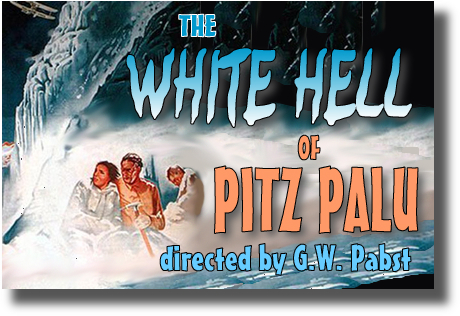

Pitz Palu is no mere dramatic figment of some author's invention; it is a famous peak in the Swiss Alps whose lofty heights command a picturesque valley.
Dr. Arnold Fanck was renowned for mountaineering films such as The Sacred Mountain (1927, with Leni Riefenstahl and Luis Trenker); G.W. Pabst was even more renowned for films with personal and psychological themes - Joyless Street (1926, with Greta Garbo), Secrets of the Soul (1926, with Werner Krauss), Love of Jeanne Ney (1927, with Brigitte Helm), Pandora's Box (1928, with Gustav Diessl, Francis Lederer, and Louise Brooks). Then came Pitz Palu, followed by Westfront 1918 and the famous Kameradschaft. Fanck followed with Avalanche and The White Flame. Small wonder, then, that when these two directors worked hand in hand on a simple but authentic story set against Palu's grim mystery, they produced a film which vividly depicts the character of the mountain, as well as of the handful of humans involved.
A honeymoon couple on Palu meet a Dr. Krafft and hear the
story of how he haunts the mountain after having tragically lost
his wife there. Against a guide's advice, they set out to scale
the North Wall; they get trapped and are seen by a party of students
who are killed while attempting to reach them. Search parties
set out by torchlight and, 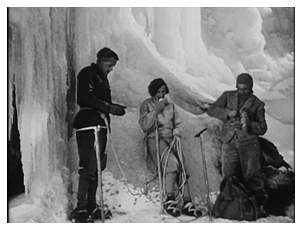 at dawn, a plane is
sent and locates them at last. Finally, the searchers reach the
young couple, but Krafft has sacrificed his clothes for them and
has gone to join his wife in the White Hell of Pitz Palu.
at dawn, a plane is
sent and locates them at last. Finally, the searchers reach the
young couple, but Krafft has sacrificed his clothes for them and
has gone to join his wife in the White Hell of Pitz Palu.
Brilliant Narration
The story is brilliantly narrated in terms of screen action, and in addition it is a framework on which is hung the epic theme of man's struggle against the mountain. This theme is subtly emphasised by contrasting incidents in the narrative which show the mountain in all its various moods; we first see it in sparkling sunshine - the honeymoon couple is introduced, and Palu smiles on them.
Then comes a foretaste of the dangers in the doctor's story. Then a suggestion of the thaw at sundown and the guide's warning - disregarded when the three set out on the calm and inviting slopes at dawn. Then the accident, at which Palu stands aloof while the human batters himself on a minor precipice. Then the ominous rumble of the falling snow, and a party of students is blotted out, hurled into a deep chasm. And the bitter cold of night with wind and fine snow - and searchers setting out with torches like pinpoints on the mountainside, up crags and deep down into chasms of ice, chill glittering tombs where the students are found.
Then another dawn, and ironically sparkling sunshine, and a plane like a fly over the lofty peaks. Then again the mists begin to rise, and bitter coldness returns, but the searchers find the couple, preserved from death though Krafft has given himself up to Palu. And in the valley there is brightness and sunshine, and the dangers of the mountain are remote and almost unreal.
Such is the story, theme, and treatment-synopsis of this famous picture; and before proceeding to analyze it in respect of its direction, photography, acting and montage, there are a few points worth noting. Production was completed on location (round and about Pitz Palu) in the summer and autumn of 1929. The few interiors of the hut, church, and glimpses of houses were also done on location and lit by daylight plus portable supplementary lighting. Pabst and Gustav Diessl were "ex-studio," but Fanck, Leni Riefenstahl, and the other players were experienced climbers. Captain Udet, the Airman, was a famous war-ace.
Virile Contrast to Talking Films
The film was handled in England (and America) by Universal Pictures, and released in February 1931 when it was received with acclaim everywhere as a fresh and virile contrast to current talkies which reeked of the studio. Contemporary talkie releases were All Quiet on the Western Front, The Big House, The Blue Angel, and Holiday. A specially written musical accompaniment was synchronized with Pitz Palu, and later an alternative version was offered with a "dramatic commentary" at certain parts of the film. The public showed good taste by preferring the original version; and it is of great interest to note the remarks of the reviewer in the trade paper, To-day's Cinema, dated September 6, 1930: "The commentary is well done, but is redundant, and although it occurs quite seldom, it never fails to be intrusive. This picture, in fact, is the final answer to the question, 'will silent pictures disappear?' Such silent films as The White Hell of Pitz Palu will always be welcome, wherever there are audiences to react to a stirring tale of human endeavour, incredible danger, and sheer beauty."
The sub-standard 16mm prints are complete, but the 9.5mm version has been reduced to just under half the original. This results in a certain loss of characterisation, some continuity jumps, and a bunching up of incident, but it has been cleverly done. The spirit and all key sequences remain, and in view of widespread use of this version, it will be used as the basis of the survey that follows. It remains finally to remark that the film was shot, and is intended to be shown, at 20 to 22 frames per second.
Vivacious Acting
Pabst opens his film in a light key, catching at once the spirit of the honeymoon couple and of Palu in a smiling mood. Sparkle is achieved by vivacious action and flying snow photographed in hard focus. Then back to the hut where the man has rigged up a birthday cake and candles - a neat bit of character comedy when the girl peeps through her fingers at this surprise, then a good first title: "Your birthday, Maria - and our honeymoon - on Palu." They pick up the log-book in the cabin and find the tragic entry by Dr. Krafft on the occasion when his wife failed to return: "Maria did not return. She is in the North Wall."
At once sinister significance is attached to the North Wall, and it was a point of ingenuity to give the same name, Maria, to both girls: a bond of sympathy is evoked. The living Maria looks up in a beautifully modelled close-up. We follow her gaze and see through the cabin window the North Wall, the scene of the tragedy. The husband recalls how Dr. Krafft now haunts the mountain, and at his words there is a great gust of wind that blows out the birthday candles. We immediately cut to a low-angle shot of Krafft in the doorway.
Now follows a typical Pabst intimate sequence wherein every shot is cut on action so that one hardly notices the changes of camera angle. The two are nervous and make a business of taking Krafft's rope and making tea, and the husband fidgets more and more and eventually goes out. Krafft's nerves are shown to be on edge by his subjective reaction to a dripping icicle seen through the window.
Maria is filled with sympathy and persuades him to tell his story, which is done in a flash-back. We see him and his wife and Christian, the guide, on the North Wall, and the slides are starting, so Christian shouts a warning from above. Krafft's head is shown in close-up in the bottom corner of the frame as he shouts reassurance and follows a close-up of his hand gripping the rope. They proceed downwards, his wife leading. She passes out of the frame, then cut to M.S. of deep chasm, the shot being held 35 frames before she enters. This is a superb example of emphasis by disregard of the normal method of removing static frames before the start of the action. The chasm at first seems small and picturesque; the appearance of the human figure in the top corner of the frame instantly adds sinister significance. Then:
M.S. Krafft watches her progress
M.S. the rope between them tautens -
L.S. a huge block of ice breaks away from the heights
C.S. Krafft looks up-looks round in horror -
L.S. the ice falling
C.S. Krafft jerks his head round, shouts warning - in three short
shots the block crashes down
C.S. Krafft shouts again -
M.S. the block lands on the rope -
C.S. the girl screams -
L.S. a further fall of ice and snow -
L.S. the girl is swept away
L.S. over a precipice
M.S. Krafft pays out rope
L.S. the girl falls deep into a chasm
Then mechanically Krafft pays out more rope, though he knows
it has broken, and the sequence ends with a close-up of his snow-covered
hand, his fingers loosening their useless hold, and the frayed
end telling again the grim story. Dramatic emphasis in this superb
sequence is increased by the jerky movements of Krafft's head
in his three 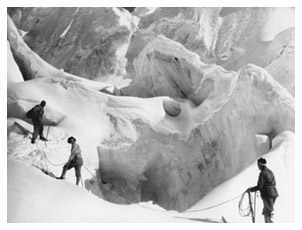 close-ups (director's control);
and the three short shots of the crashing ice have far more power
in their speeded-up tempo than would one shot alone - a fairly
common montage effect used by all good editors, particularly the
Russians. In only the last of the three shots of the girl's fall
is a dummy used; the others were shot at half speed, the girl
being carefully lowered as required.
close-ups (director's control);
and the three short shots of the crashing ice have far more power
in their speeded-up tempo than would one shot alone - a fairly
common montage effect used by all good editors, particularly the
Russians. In only the last of the three shots of the girl's fall
is a dummy used; the others were shot at half speed, the girl
being carefully lowered as required.
Krafft associates the disaster with the dripping of water in the thaw; he leaves the cabin to smash the dripping icicle.
The husband returns with Christian, a natural type established by the directors with a studied match-striking characteristic. He strikes one (on the table top) out of the frame area to light the cabin lamp (while outside Krafft turns up his collar - thus expertly is the chill of evening portrayed); and later he strikes another, but only at the second rub! He leaves the cabin, meets Krafft; cut to a beautifully composed shot of moving cloud-banks in the darkening sky, and a comment on dangerous weather approaching.
Majestic Shots
At dawn Krafft sets out to climb the North Wall, and the husband goes with him. Maria sees them go, and follows. Inserts of log-book entries explain the action and enable it to be conveyed with an economy of shots. The directors continually insert character touches: the extended log-book entries; Maria obviously awake all the time; Krafft's reference to the students as "Young fools" when they are seen already to have started their climb! Maria skis up and asks Krafft (not her husband) if she may come. At last he agrees.
The climb, first by ski, then ice-boots and axes, is rendered now in majestic long shot, shot now up a sheer wall of glittering ice. They gain a wide ledge and pause, but ominously the slides start, so they must push on. The husband now feels the urge to assert himself and insists on leading: this is superbly handled by Pabst:
(pan) C-M.S. his feet pass Krafft's
C.S. Krafft puts a restraining hand on his arm.
C-M.S. Krafft slowly shakes his head.
TITLE: "It's madness-you will kill us all."
M.S. (of husband, with Krafft's back near camera) Krafft makes
strong gesture of protest -
C.S. husband obstinately disregards protest -
C-M.S. Krafft repeats warning, but Maria asks
C.S. asks, so he gives in -
L.S. the husband proceeds
The shot immediately succeeding the title is a masterpiece of concise expression.
The ice slides ominously continue, and Krafft shouts (with reason plus very human irritation), "Hurry, hurry!" The repetition of the word is admirable, another instance of titling skill. The slides get worse, and as was inevitable, the man is dashed down the mountain side. Only Krafft's strength, vividly expressed by a perfectly chosen low-angle shot, saves him. He hangs limp from the rope against the sheer ice.
The students see the accident and set off in their attempt to help. Meanwhile, Krafft reaches and rescues the husband. The students are swept away by a huge fall. These scenes are done in a remote detachment, the students mere specks on Palu's vast whiteness. Krafft regains the ledge at the expense of a damaged leg: a sinister shot of drifting cloud-shadow in a remote valley is contrasted with the three trapped climbers.
In close-up, Krafft shouts a loud "haloo-oo" in
the hope of attracting attention: in remote, grey long-shot the
cold, distant peaks and valleys idly echo back the cry. He shouts
again: cut again to slow pan of deserted surrounding peaks. In
a valley, Christian skis home. At last he pauses. He has heard.
He hurries away, and we notice how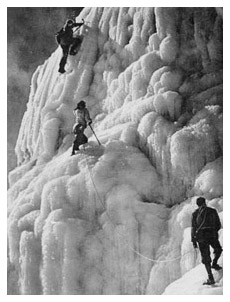 the
mists are rolling down into the valleys. Icy wind stirs the trapped
climbers on their high ledge. Krafft gives up his woolen helmet
to the husband.
the
mists are rolling down into the valleys. Icy wind stirs the trapped
climbers on their high ledge. Krafft gives up his woolen helmet
to the husband.
Naturalistic Portraits
Christian goes from window to window in the village with the call, "Trouble on the Palu!" Naturalistic portraits are given in close-ups of the villagers as they open their frosted windows to respond. The bells are rung. Women and aged folk bid God-speed to the searchers who move off with flaming torches in the black night. The directors have here magnificently employed natural types, and the cameras record light and shade in sweeps of rare beauty.
On and on, up the mountain - icy vapour rolls down the North Wall - a red-filter "night" shot of astonishing dramatic power. Krafft swings a lamp. The cold is intense. The husband's injury begins to tell. Krafft has to give up his coat. Maria tries to refuse. The searchers proceed down into the chasms of ice where unique photographic effects result.
It might be thought that here were opportunities that could not be fluffed, but it should be noted that these chasm shots are most carefully arranged, and the grouping of the searchers is beyond criticism. The finding of the students' bodies is darkly shown, and there is one grim shot of a body, hung shapelessly, being hauled into a dome of ice.
On the ledge the husband cracks up, pushes aside his wife, and attacks Krafft. These shots are lit solely by just enough back light to show up the outlines of the players. Maria is shown in one memorable close-up when a single tear finds its way down her cheek. Then her hand picks up the rope, and she helps tie up her husband to preserve him in safety.
Sharp and Soft Focus
Dawn comes. A shaft of sunlight slants across the valley. (This has very effectively been double-exposed on to the L.S.) In full close-up, the sun spreads across Krafft's face (very effective: done by sliding away large screen during the shot). The sun's low beams are shown in distant shot of long shadows. Udet sets out, and his plane combs the icy wastes. He locates them and drops a note which is recovered by Christian. He tries to drop food, but his parachutes miss. In sharp focus close-up, Maria watches the parachutes; in soft focus, she realizes they have missed.
The searchers are spurred on and, in more of Dr. Arnold Fanck's well-chosen sweeping movements, they return to the fight against the mountain. Again, bitter cold descends. The bound man freezes. Krafft gives up his jacket. Then he stands shaking with cold in a sequence of rare perfection of acting, direction, and cutting:
C.S. (head only) he shakes with cold: his teeth chatter
C.S. (shoulder to waist) he slowly beats his arms -
L.S. he stands with his arms still, the wind flaps his shirt
M.S. (gauze diffused) as last shot. He looks upwards
L.S. Mist rolls down the North Wall
M.S. he painfully gets out a book
The last two shots explain his idea to walk into the depths of Palu to rejoin his wife. The searchers get near. In the village, prayers are offered in the church. Then the shout, "They are coming! They are coming!" (Another title given emphasis by repetition of the wording). In a sparkling curve, the searchers ski back with news of the rescue. At the cabin, the young couple are rubbed with snow. Maria asks, "And - Dr. Johannes?" Christian hands her the book with its last message, "Dear old Christian - don't try to find me, save the others. I have gone to her."
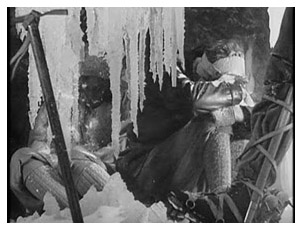 Silent film art, as exemplified
in many sequences of The White Hell of Pitz Palu, can be
of great beauty and appeal; and the writer sincerely hopes the
foregoing survey will give pointers to an additional enjoyment
and appreciation of the film. Furthermore, by such analysis, one
is enabled to better one's own film technique by profiting from
methods which can be seen to have been successful. In conclusion,
a very brief summary of the production phases will help to clarify
the essential co-operation that leads to success:
Silent film art, as exemplified
in many sequences of The White Hell of Pitz Palu, can be
of great beauty and appeal; and the writer sincerely hopes the
foregoing survey will give pointers to an additional enjoyment
and appreciation of the film. Furthermore, by such analysis, one
is enabled to better one's own film technique by profiting from
methods which can be seen to have been successful. In conclusion,
a very brief summary of the production phases will help to clarify
the essential co-operation that leads to success:
Direction
It will have been noted that Pabst with his intimate touches, skilled grouping, and picking out of the key details of each sequence presented clear characters and a pure and straightforward narrative. Fanck, experienced in the mountain settings, enabled Palu to be shown as an almost-alive being.
Acting
This, with a mixture of film players and natural types, succeeds particularly on account of sensitive direction. No false note occurs throughout. This is assisted, of course, by the players being largely unknown to English audiences. Charles Laughton could act Krafft; Diessl was Krafft.
Photography
Three cameramen were responsible, none of them especially famous; and, in fact, there is a definite unevenness in composition. There is, however, great technical competence; snow scenes are particularly difficult to render uniformly and with good contrast. In particular, the men behind the cameras are to be congratulated on achieving both the Fanck mountain vastness and the Pabst complex intimacy without loss of reasonable style - and without falling into the temptation of giving a display of technical cleverness.
Design
This is comparatively a small item, being confined to the cabin interior arrangements and details in the village. The impeccable realism is the best tribute to Erno Metzner. It is possible that he also assisted in grouping and arrangement in the chasm scenes, such is their compositional purity.
Montage
Pabst's famous cutting-on-action (so that an action is continued through the cut, thus masking it) is less in evidence here than in his earlier films, partly due to the lack of many intimate scenes. In the abridged version, of course, it has been in many cases upset by the removal or pruning of shots. The film is, in general, notable for concise rather than spectacular cutting, examples of concise excellence being observed in the quoted extracts from the scenario and also such sequences as Krafft's shouts for assistance and the struggle on the ledge.
There are memorable moments in Pitz Palu. Time does not wipe from one's mind the image of Krafft's frantic shout to his wife; the line of students hurled down the chasm; the dancing light of the torches; the chill mist rolling down from the North Wall; the aeroplane over the mountains; and Krafft in his last moments of unbearable cold; and the hazy softness of Maria, recovering.
Such are flashes of memory from an epic. Come what may,
in the way of sound, colour, stereoscopy and other desperate strivings
after synthetic realism, I personally believe that a film like
The White Hell of Pitz Palu will always evoke the appreciation
of a discerning audience.
NOTE: "G.W. Pabst was greatly impressed by Abel Gance's La Roue (1922), the second half of which takes place in the Alps. A DVD is distributed by Flicker Alley. A DVD of The White Hell of Pitz Palu is distributed by Kino Video." (KB)